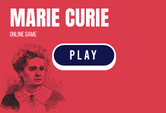Marie Curie Facts Game Quiz Online
This page features a Marie Curie Facts Game Quiz Online. It is a great exercise for students in 3rd to 9th grades. Marie Curie was a Polish born chemist whose ground breaking research in radioactivity contributed a lot to nuclear physics and contemporary medicine. In this game, students will learn about this iconic figure. It is an interactive online quiz with 15 test questions to answer and learn. Play the game and if you enjoy it, please remember to share it.

You may have heard of Marie Curie, the Polish-born, French-naturalized chemist who won two Nobel Prizes. But did you know that she was also a pioneer in radiation research? If not, read on to discover more about this brilliant woman. Here are some facts about Marie Curie, including her life story and scientific contributions to humankind.
Marie Curie was a chemist
Marie Curie was an accomplished Polish naturalized Frenchwoman, who became a world-renowned chemist for her pioneering work on radioactivity. Her contributions to science were not limited to her work on radioactivity, but her pioneering studies in this field impacted the lives of millions.
Her achievements were not limited to chemistry; she also discovered the elements polonium and radium. In fact, she was the first woman to receive two Nobel Prizes, and is the only person to have won the award in two different fields. Her discoveries attracted the attention of scientists across the globe, and she was invited to attend a physics conference with Albert Einstein. She was so influential in the field of chemistry that her work was often credited for bringing the field of physics to the forefront of scientific discovery.
She was awarded two Nobel Prizes
In 1911, Marie Curie was honored with two Nobel Prizes. The first prize was for her discovery of radium, which was much more radioactive than uranium. The second prize was awarded for her discovery of polonium, another radioactive element. Her discoveries eventually led to radiation therapy in medicine. Curie's discoveries continue to be influential today.
In 1898, she published strong evidence of the existence of radium, but she still had no sample. Her solution was to purchase worthless waste pitchblende in Austria, which contained much higher levels of radioactivity than the original pitchblende. She then began processing this material to extract the radium. The work involved grinding, filtering, and crystallizing large batches of the material. The resulting radium was then isolated from the waste material and used in medical research.
She was a pioneer in radiation research
She pioneered the use of ionizing radiation to treat cancer and for nuclear energy. She was also the first woman in Europe to obtain a Doctor of Science degree. Marie Curie's contributions were so impactful that she became an icon for women in traditionally male fields. In addition to her groundbreaking work, Curie also paved the way for women in radiation sciences.
After observing the emission of high-energy rays from uranium, Curie built on Becquerel's work. Uranium exhibits no apparent chemical or physical transformation, yet it emits rays of high energy. Curie wondered if these rays were breaking a basic thermodynamic law. Eventually, she and her husband discovered polonium, the first element ever named after a woman.
She was a female scientist
The life and work of Marie Curie is a fascinating one. Born Maria Sklodowska in Warsaw, Poland, she was the daughter of modest school teachers. Determined to pursue a career in science, she agreed to support her sister's medical studies in France by working as a governess. She moved to Paris to attend the Sorbonne, where she studied physics, mathematics, and chemistry.
As a mother, Marie Curie continued her rigorous scientific career. In 1897, she gave birth to her first child, Irene. The difficult pregnancy forced her to spend less time in the lab. She also worked as a lecturer in physics at Sevres Normale Superieure School, where she introduced the use of experiments in teaching. In December 1904, she was appointed the chief assistant in Pierre Curie's laboratory.
She died of radiation-induced leukemia
In 1898, Marie Curie discovered a new element, polonium, after her native country. Shortly afterward, radium was discovered. Curie was the first to use the term "radioactivity" to describe radiation produced by atomic decay. However, her scientific breakthroughs did not last long. After her death from radiation-induced leukemia at the age of fifty-seven.
She was also plagued by double cataracts, which caused her to undergo four operations to restore her eyesight. She also had severe burns due to handling radioactive materials, and was later diagnosed with pernicious anemia. Marie Curie died of radiation-induced leukemia in 1934. Her work contributed to the understanding of how radiation affects humans. During World War I, Curie was instrumental in diagnosing battlefield injuries and her work at X-ray units became famous and her X-ray stations were nicknamed "petite Curies."
